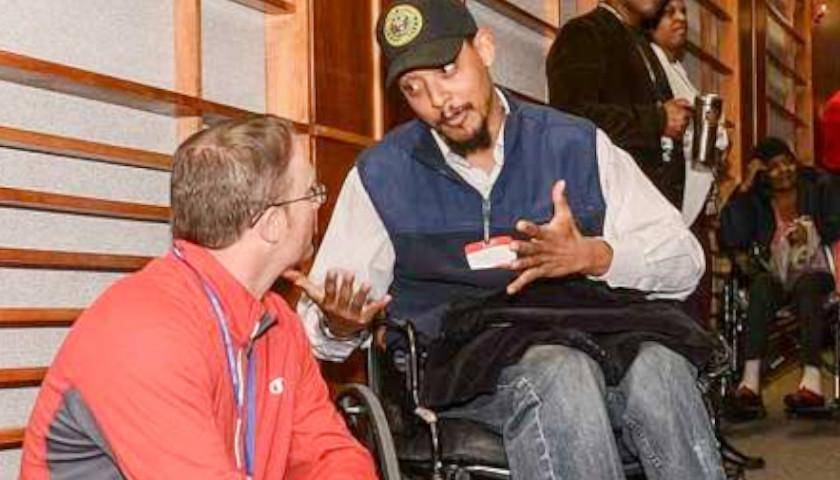GOP gubernatorial candidate Jeff Johnson has raised the trifecta of issues facing states where the federal government’s contractors are resettling refugees – cost, transparency and accountability. Johnson’s call to pause refugee resettlement in Minnesota demonstrates his understanding that costs being forced onto the state to pay for the federal program is a double whammy for state taxpayers.
Using Minnesotans’ state income tax dollars and it’s generous Medicaid eligibility which was expanded by Governor Dayton in 2013, to pay for refugee health costs, shifts more of what Congress said they would pay when they launched the refugee resettlement program.
Unlike other legal immigrants admitted to the U.S., refugees including those that settle in Minnesota, are not barred by immigration-related waiting periods before applying for state Medicaid programs. Even though refugees must meet all Medicaid eligibility requirements in order to receive coverage and services, the high concentration of primary and secondary refugee populations that data suggests struggle with unemployment and poverty, also strongly suggests that refugee Medicaid enrollment in Minnesota is high.
A 2017 report released by The Minnesota Budget Project, a non-partisan project of the Minnesota Council of Non-Profits, confirms that recent immigrants to the state have higher unemployment rates than native-borns and that it takes approximately 10 years before the immigrant unemployment gap begins to decrease:
The unemployment rate of those who have moved to Minnesota from another country most recently is higher than the overall unemployment rate, with an unemployment rate of 6.2 percent compared to the statewide average of 4.5 percent.
Last week, the Budget Project also confirmed that the 2017 poverty rate among “Black/African American Minnesotans,” the group in which refugees from Africa are typically included, is at 28.2%.
Data compiled by John Palmer, a retired faculty member at St. Cloud State University claims that “Somalis have the second largest percentage with 40% of their 16-64 year olds out of the labor force or unemployed” and compared to other ethnic groups, had the lowest median income:
Black and Somali households have much less income on average than White households and they, on average, are more likely to need government assistance or charity to pay for household’s living expenses.
The Twin Cities Pioneer Press reported that “Minnesota has the highest number of refugees per capita nationwide, according to the U.S. Census and refugee-support agencies. With 2 percent of the nation’s population, Minnesota has 13 percent of its refugees.” Minnesota is also reputed to have the largest Somali population in the U.S..
Minnesota’s Medicaid program is funded through a dollar match where the state and federal governments each pay part of the cost. Through federal shifting of Medicaid costs associated with the refugee resettlement program, the state now also pays the portion of the state’s cost that was, at one time, reimbursed to the state as authorized by the federal legislation.
The federal government began shifting the costs of its refugee program back to state governments shortly after the passage of the Refugee Act of 1980. The cost shifting has been documented in Congressional hearings and by the General Accounting Office in different reports including Refugee Resettlement: Federal Support to the States Has Declined:
With reductions in federal refugee assistance, costs for cash and medical assistance have shifted to state and local governments. Available data indicate that states resettling most of the refugees incur millions of dollars in transferred costs – the most recent estimate is $85 million for fiscal year 1990. However, these costs represent a very small percentage of total state expenditures for cash assistance.
The issue of federal funding support for newly resettled refugees was front and center during deliberations in Congress before the 1980 Act was passed. Congress well understood that reimbursing state incurred costs was essential to getting state governments to support the new refugee program they were creating. But the House and Senate differed on just how much funding responsibility the federal government should assume. The House bill would have provided 4 years of medical and cash assistance while the Senate bill version only called for 2 years of federal support.
On this point, Rep. Holtzman, the House sponsor, was fairly emphatic when presenting the bill on the House floor:
In my judgment, it is essential that we continue to receive the full support of State governments for our refugee programs; I believe that we would jeopardize that support and cooperation if we were to transfer the resettlement burden to the States after the refugees have been in this country for only 2 short years. While most refugees are quickly integrated into American society some adjustment problems do occur in the first few years and I do not believe we should require States to respond to these residual problems with their own resources. In short, full reimbursement for a 4-year period represents, in the committee’s judgment, a proper allocation of Federal and State responsibilities for the care and resettlement of refugees.
As if often the case with legislation, the issue was resolved through a conference committee. In his paper tracing the legislative history of the 1980 Act, Senator Ted Kennedy, the Act’s chief sponsor, confirmed the federal government’s fiscal responsibility for its program:
The widest difference between the Senate and House versions of the Act was on domestic
resettlement assistance. Because the admission of refugees is a federal decision and lies outside normal immigration procedures, the federal government has a clear responsibility to assist communities in resettling refugees and helping them to become self-supporting. The basic issues here [in conference committee] were the length of time of federal responsibility and the method of its administration. State and local agencies were insistent that federal assistance must continue long enough to assure that local citizens will not be taxed for programs they did not initiate and for which they were not responsible.
Congress ended up providing two funding streams to support refugee resettlement. One funding stream authorized 36 months of reimbursement for 100% of the state’s cost of Medicaid, cash welfare and SSI for each resettled refugee. The other funding stream, also authorized for 36 months, was to support refugees who were not eligible for the state-federal funded public assistance programs.
Two short years after the 1980 Act was passed, federal cash and medical assistance was reduced for refugees who couldn’t enroll in state public assistance programs. By 1991, the federal subsidy for this group of refugees was reduced to 8-months of support. It is this 8-month subsidy along with federal grants and the per-refugee fee paid to resettlement contractors that those who profit from the refugee industry claim is a program almost entirely paid for by the federal government. This claim does not account for refugees who enroll in state funded public assistance programs.
By 1986, the other authorized funding stream providing reimbursement to states for the state-funded expenditures to support refugees began reducing and was eliminated altogether by 1991, shifting the short and long-term costs to the states.
Ten years later during a Congressional hearing about turning the refugee program over to its profiteers, the problem of the federal government forcing states to use state taxpayer revenue to pay for the refugee program was raised again, this time by Democrat Rep. Harry Condit from California:
Despite the fact that the federal government has, in the past, made commitments to fully support refugee resettlement, this commitment has not been met for many years. It is unconscionable for the federal government to place refugees in communities without providing resources for their resettlement. After all, the local communities had no role in the high-level foreign policy decisions which resulted in the refugee admissions.
The Illinois State Refugee Coordinator made the point even more directly:
The Refugee Education Assistance Act has not been funded since 1987. The Refugee Program has been sustained through major cost transfer to state and local governments…I think it must be recognized that the refugee program, in fact, has survived for the past 10 years on cost-transfer to the State and local Government.
In 2010, the Democratically controlled Senate Foreign Relations Committee looking at problems with the refugee program also criticized passing the costs onto state taxpayers but elected not to do anything to address the problem.
One state, however, is challenging the federal government’s commandeering of state funds to pay for the federal resettlement program. In 2017, the State of Tennessee and its General Assembly, represented by the public interest firm the Thomas More Law Center, sued on a Tenth Amendment legal theory. The case has been appealed to the U.S, Sixth Circuit Court of Appeals after the lower court, which did not address the substantive issues asserted, dismissed the case for alleged lack of standing.
Unlike Minnesota Tennessee has not expanded its Medicaid eligibility. However, the refugee Medicaid cost-shifting issue is central to Tennessee’s lawsuit. Data provided to The Tennessee Star by State Senator Bill Ketron’s office showed that “in FY2010, federal contractors resettled 1,734 refugees in Tennessee and 1,157 in FY2011. Forty-eight percent of the refugees arriving in 2010 and 58 percent arriving in 2011, were assisted by refugee contractors to enroll into TennCare [the state’s Medicaid program].”
Johnson, who understands the state sovereignty issues embedded in the federal program cost shifting and the significant cost implications for Minnesota taxpayers, has stated his support for considering legal action like the Tennessee lawsuit.
– – –
Chris Alto is an investigative reporter at The Minnesota Sun. Photo “Jeff Johnson” by jeffjohnsonforgovernor.com




